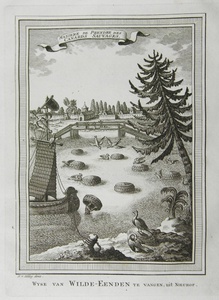| Method | Copper engraving |
| Artist | Jakob van der Schley |
| Published | [A la Haye, Chez Pierre de Hondt, MDCCXLIX. Avec Privilege de Sa Majeste Imperiale, & de Nos Seigneurs les Etats de Hollande & de West-Frise. 1749] |
| Dimensions | Image 191 x 140 mm, Plate 214 x 184 mm, Sheet 265 x 219 mm |
| Notes |
A depiction of Chinese game-hunters from the Dutch edition of the Description de la Chine, part of Prévost's monumental 'l'Histoire Géneral des Voyages.' The plate depicts a method used by Chinese hunters for catching wild ducks. The hunters climb into the water, and cover themselves with wicker baskets that float on the surface. When the ducks stray close to the baskets, the hunters grab their feet under the water, thus catching them. In the scene, one hunter, waist-deep in the water, is about to conceal himself. A number of other baskets on the lake's surface mark other hunters, two of which are in the process of dragging the ducks under the water. A shallow-keeled sailed boat is moored to the bank, and in the distance, a small walled town can be seen beyond a bridge over the lake's inlet. The scene is based on a description by Johan Nieuhof. The Histoire Géneral des Voyages was a monumental eighteenth century general history divided according to geographic region. The original volumes were written by Antoine François Prévost d'Exiles, a French author, novelist, theologian, natural historian, and a priest of the Jesuit and Benedictine orders, but continued by numerous other authors after Prévost's death. The earliest books mostly deal with the Far East and South-East Asia, providing a general history of their regions, kingdoms, customs, culture, costumes, natural phenomena and religious beliefs. Much of Prévost's information is derived from the reports of Jesuit missionaries, Portuguese merchants, and famous explorers, from Marco Polo to Sir Francis Drake. Although written in French, the popularity of the Histoire among Dutch audiences meant that many of the illustrative plates and maps published to accompany the work were either re-engraved or subtitled in Dutch by the engraver Jakob van der Schley. Prévost himself had travelled widely throughout the Netherlands, launching his literary career in Amsterdam and the Hague after fleeing the Benedictines in France. Prevost's work on China, and indeed many of van der Schley's plates, owe a great debt to Johan Nieuhoff (1618-1672) , a Dutch traveller who explored much of China, India, and Brazil while in the employ of the Dutch East India Company. Nieuhoff wrote extensively, with a particular focus on China, for his memoirs, and his numerous drawings of Chinese places and people were much copied by later engravers for numerous works of Chinese interest. Nieuhoff's own book became a major source of inspiration for eighteenth century chinoiserie, and are amongst the first western illustrations to depict the Chinese people in a manner which was based upon personal observation rather than the tradition of oriental fantasy. Jakob van der Schley (26th July 1715 - 12th February 1779), also known as Jan von Schley or Jacobus van Schley, was a Dutch engraver and draughtsman. An apprentice of the French engraver Bernard Picart, he is best known for his engravings of the majority of plates in the Dutch edition of 'l'Histoire Géneral des Voyages.' Despite producing mainly maps and views for this work, van der Schley was predominantly a portrait artist and literary illustrator. Condition: Sheet trimmed within plate on right margin, as issued. Binders crease and holes to left margin. Clean, crisp impression with partial fleur-de-lis watermark. |
| Framing | unmounted |
| Price | £45.00 |
| Stock ID | 40817 |

